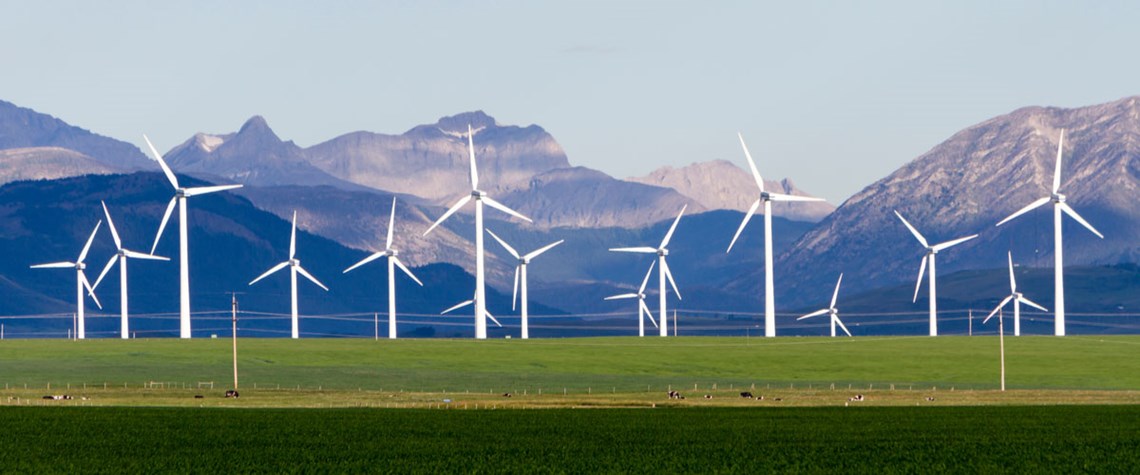The Canadian province of Alberta is showing strong renewables growth, with more expected. Consultancy Rystad Energy forecasts that 95pc of all new renewable power projects in Canada through to 2025 will be in Alberta. Many of the world’s largest and most sophisticated renewable developers and financiers are active in the Alberta market. Renewables accounted for 16pc of the province’s generation capacity in 2017. By 2023, this figure is expected to be 26pc.
The Alberta Electric System Operator (AESO), Alberta’s independent system operator, has forecast in its reference case in its 2021 Long-Term Outlook that 3,127MW of new wind capacity, 1,018MW of new solar capacity and 150MW of storage capacity will be online in Alberta by 2041. In its ‘clean tech’ scenario, which considers an upside to trends in decarbonisation and renewable growth, the AESO is even more bullish, predicting 3,667MW of new wind, 2,698MW of new solar and 1,520MW of new storage capacity. RBC, a Canadian bank, expects 61 new solar projects to come online in Alberta by 2025.
There are several reasons for this growth. First, Alberta has world-class wind and solar resources and room to build projects. For instance, Southern Alberta averages 2,500 hours of sunlight per year, a solar resource greater than Germany and equivalent to Florida or Rio de Janeiro; Southern Alberta’s wind resources, which blow across its approximate 100,000km², are among the strongest in the world.
Second, although Alberta has historically been dominated by coal-powered generation, coal retirement is happening faster than expected. The government’s legislated target for a complete phase-out of coal-powered generation is 2030, but coal is expected to be gone from the Alberta grid by 2023 due in part to natural gas conversions and the falling capital costs of renewables. In January 2022, for the first time in over 80 years, wind power contributed more to Alberta's grid than coal for several days.
Third, government support and programmes have increased capacity. In 2017-18, AESO ran a competitive procurement to incentivise the development of large-scale renewable projects and awarded 1,363MW of renewables contracts. Other government programmes for municipalities, communities, indigenous interests, farms and residences have also encouraged growth.
Fourth, as elsewhere, the capital costs of renewable projects continue to fall and now compete with natural gas-powered generation, generally without the need for government subsidies. According to the AESO’s Long-Term Outlook, the capital costs of new wind facilities between 2021 and 2025 are estimated at $1,586/kW, and after 2025 at $1,105/kW.
The AESO estimates the capital cost for new solar in 2021-25 at $1,643/kW, and after 2025 at $1,388/kW. For comparison, the capital cost of combined-cycle natural gas power production is estimated by the AESO at $1,667/kW.
Carbon price
Fifth, Alberta has a carbon price (that keeps increasing) and an active carbon offset credit market. Under provincial carbon laws, large industrial emitters must reduce their greenhouse gas emissions and may do so in part by acquiring and retiring offset credits from renewable power and other projects. Currently, the legislated price of carbon is C$40/t, and this will rise to $50/t in April 2022. The Canadian government has announced it will increase the carbon price annually by $15/t until it reaches $170/t in 2030. Many large emitters are investing in renewable projects to generate offset credits they can retire to meet compliance obligations.
Sixth, in addition to large industrial emitters seeking offset credits, ESG buyers are firmly in the Alberta market contracting for green energy and carbon credits. RBC, e-commerce giant Amazon, Swedish furniture maker Ikea and others have entered into power-purchase agreements with renewable developers in Alberta.
Deregulated market
Finally, and perhaps the most important reason for the recent renewables growth, is that Alberta’s power generation market is the most deregulated in Canada. A renewables developer in Alberta does not need to demonstrate to a regulator the economics of their project—they, their financiers and offtakers bear the risk of project economics. Wholesale power prices are set through the Alberta Power Pool, a competitive market where electricity is bought and sold.
Interconnection to the grid is overseen by the AESO, which has a legislated mandate to provide all market participants with a reasonable opportunity to access transmission services. Environmental permitting is through the independent Alberta Utilities Commission. Unlike most other Canadian jurisdictions, there is no vertically integrated, government-owned utility in Alberta that controls the electricity market and which a developer must contract with to bring a renewable power project into operation. Renewable developers, carbon credit compliance buyers and ESG-minded parties have limited renewable opportunities in Canada outside of Alberta.
Only time will tell the extent of the build-out of wind, solar and other renewable projects in Alberta. But for the time being, the Alberta renewables market is experiencing strong growth.
Alan Harvie is senior partner at international law firm Norton Rose Fulbright in Calgary








Comments